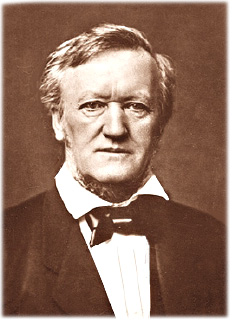...Best of Sicily presents... Best of Sicily Magazine. ... Dedicated to Sicilian art, culture, history, people, places and all things Sicilian. |
by Beniamino Inserra | ||
Magazine Index Best of Sicily Arts & Culture Fashion Food & Wine History & Society About Us Travel Faqs Contact Map of Sicily |
One was Italian and the other German, and both had important and specific cultural links with the city of Palermo, though in vastly different ways. Of course these two titans of the grand opera were none other than Giuseppe Verdi and Richard Wagner (shown here). Briefly, Verdi was born in a small village in northern Italy, near Parma, in 1813 and over time became the greatest creator of the "bel canto" style of Italian opera favored by Vincenzo Bellini. Out of many memorable classics of the Italian operatic theatre, one was written to commemorate a tragic event in the history of Sicily – I Vespri Siciliani, produced for the Paris Opera in 1855 to great acclaim. This melodic masterpiece recounts the historic rebellion of the medieval Sicilian populace against Angevin troops occupying Palermo in 1282. This opera has enjoyed continuing success over the years, being received as well as some of Verdi's better-known works, like Rigoletto and La Traviata, and the ever-popular Aida. It remains a perennial favourite for Verdi aficionados and experts. Incidentally, it is the second most performed opera featuring a Sicilian locale, the other being Mascagni's Cavalleria Rusticana set in the town of Vizzini. The site of the historical Sicilian Vespers is the Church of Saint Ursula in what is now the Santo Spirito Cemetery. The other titanic musical figure is Richard Wagner, born in the same year as Verdi, and in many ways his greatest cultural, linguistic and musical rival. While Verdi perfected the older form of Italian opera known as "bel canto" (beautiful melodic arias sung with great skill), Wagner boldly experimented with new forms of recitation and pioneered revolutionary orchestration modes. According to musicologist Herbert Weinstock, Wagner "gradually elaborated a musical idiom of extraordinary richness and complexity, sacrificing the previous operatic primacy of the voice to the expressive strength with which he wielded the large symphonic orchestra... he required a new race of singers – heroic tenors, stentorian dramatic sopranos, other vocalists capable of sustaining as elements in that magical, voluptuous, almost sexually tangible orchestral web the text of his often disjunct vocal lines." Following a rather tumultuous and controversial career, Wagner, for reasons of declining health, came to Palermo in the Winter of 1881-1882 and completed his final opus Parsifal while staying at what was built as the stately home of the Ingham-Whitaker family of Marsala wine fame, the Grand Hotel et des Palmes in Via Roma – a short walk from the Teatro Politeama opera house. The piano he used – a veritable holy grail of Wagnerian relics – is preserved in an aristocratic palazzo in old Palermo. However, even without this "sacred instrument" present, the city of Palermo is celebrating the bicentenary of Wagner's birth by staging the four operas of the maestro's "Ring Cycle" at the Teatro Massimo throughout the year. It promises to be a world-class Wagner festival to rival even Bayreuth in Germany, the "New Jerusalem" of Wagnerism. By the end of 2013, Palermo will have reminded the world that even this often-overlooked city can proudly pay homage to a giant of musical culture and play his masterpieces. About the Author: Beniamino Inserra, Best of Sicily's resident classical music expert, has written several articles for us over the years. | |
Top of Page |
 This year (2013) marks the bicentenary
of the births of two giants in the history of music – composers who not
only changed the course of musical composition and orchestration for the
entire world, but at the same time reached the zenith in perfecting their
chosen operatic techniques and styles.
This year (2013) marks the bicentenary
of the births of two giants in the history of music – composers who not
only changed the course of musical composition and orchestration for the
entire world, but at the same time reached the zenith in perfecting their
chosen operatic techniques and styles.